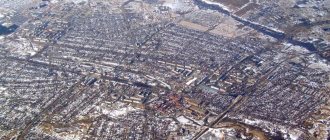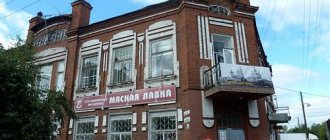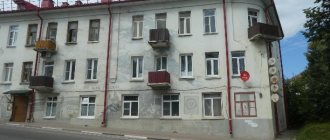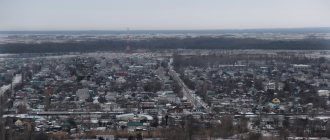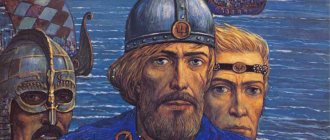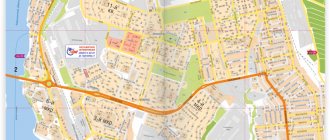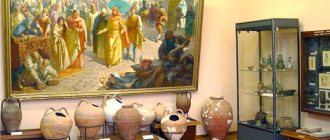BOROVSK
BOROVSK, a city in Russia, in the northeast of the Kaluga region, the center of the Borovsky municipal district. Us. 10.3 thousand people (2019). Located on the river. Protva (tributary of the Oka River), 15 km from the railway. Art. Balabanovo.
Story
Borovsk. Street in the old part of the city. Photo by A. I. Nagaev
B. was first mentioned in 1359 in the spiritual charter of Vel. book Vladimir and Moscow Ivan II Ivanovich. It finally became part of the Moscow Grand Duchy in 1382, which was secured by a treaty charter. book Vladimir and Moscow Dmitry Ivanovich Donskoy and led. book Ryazansky Oleg Ivanovich. In 1386–1456 one of the centers of the appanage Serpukhov principality. From the 15th century became one of the links in the defensive ring around Moscow, which was facilitated by the founding of a monastery near it in 1444. Nativity of the Theotokos (now the Nativity of the Theotokos Svyato-Pafnutyevsky Borovsky monastery; had land holdings in 16 districts, by the end of the 17th century it was one of the 20 largest and richest monasteries of the Russian state; in 1774 it owned 11 thousand serfs, had farmsteads in Vereya, Serpukhov, Moscow; closed in 1923, revived in 1991). During the intervention of the Polish-Lithuanian Commonwealth at the beginning of the 17th century. in 1610 B. was captured, after which the governor, Prince. M. K. Volkonsky (from the Volkonsky family) defended the monastery for 10 days from the troops of J. P. Sapega, only as a result of treason the latter managed to capture it (about 12 thousand defenders died, including M. K. Volkonsky) . From the 2nd half. 17th century Crafts developed intensively in Byelorussia (5 canvas workshops, 4 leather workshops, 5 malting handicraft workshops by the end of the 17th century). B. became one of the centers of the Old Believers (at the beginning of the 20th century, 70% of the population adhered to it). Until the 18th century the city and the monastery are a place of immediate exile and imprisonment. March – May, Sept. 1666 and in Apr. – May 1667 Archpriest Avvakum was kept in the monastery; in 1673–1675, his followers, noblewoman F.P. Morozova and her sister Prince, were imprisoned here. E. P. Urusova (both died in the fall of 1675; there are graves on the site; tombstones are in the Borovsk Museum of History and Local Lore). The district town of Moscow (1708–76) and Kaluga (1776–1924; in 1776–96 – Kaluga governorship) provinces. During the Patriotic War of 1812 the French were engaged. troops; Napoleon I in the village Gorodnya, near B., decided to retreat along the devastated Smolensk road (in B. the house where the French emperor stayed in October 1812 has been preserved); upon the departure of the French. The army burned the city and the monastery. In the beginning. 20th century In the vicinity of B., weaving (half-wool and linen carpets), gold-pounding, silversmithing, blacksmithing, and lace-making developed. Regional center of the Moscow (1929–44; in 1929–30 Kaluga district as part of the region) and Kaluga (since 1944) regions. During the Great Patriotic War, Germany was occupied on October 15, 1941. troops. Liberated on January 4, 1942 by troops of the Western Front during the counteroffensive near Moscow. Since 2004 the center of the Borovsky municipal district.
Architecture
In the center of Borovsk (regular plan of 1779; corrected by Kaluga architect I.D. Yasnygin) there is the 5-domed Annunciation Cathedral (18th century; bell tower, 1819), shopping arcades (18th century) and a center. Savior of the Transfiguration on Vzgorye with a belvedere and a 2-tier bell tower (1814). The city has preserved merchant mansions and public buildings of the 18th–19th centuries, churches: the wooden Pokrovskaya with a hipped bell tower (late 17th - early 18th centuries), Boris and Gleb (1704; bell tower, 1819), Demetrius of Thessalonica (1804), Old Believer Intercession Cathedral (1912); Nativity of the Virgin Mary at the cemetery of the former village. Grove (now within the city; 1708).
Nativity of the Virgin Mary St. Paphnutiev Borovsky Monastery. Cathedral of the Nativity of the Virgin. 1590–96.
On the eastern outskirts of Borovsk there is the Nativity of the Virgin Mary St. Paphnutiev Borovsky Monastery. The ensemble of the monastery was formed in the 16th–17th centuries: fortress walls with 6 hipped towers (including Vkhodnaya, Georgievskaya, Armory, architect T. Sharutin), 5-domed Cathedral of the Nativity of the Virgin Mary (1590–96, paintings 1644; crayfish with the relics of St. Paphnutius of Borovsky; on the site of the temple of the same name in 1467, painted by Mitrofan and Dionysius), the VMC temple added to it in 1651. Irina, refectory with c. Nativity of Christ (1511), 5-tier bell tower (3 lower tiers - 1522; upper ones - late 17th century; tiles made by master S.I. Polubes), hospital wards with a c. Elijah the Prophet (1670), abbot's corps (17th century), pillarless single-headed c. Mitrofan of Tsaregrad (1760–63). Princes Volkonsky, Repnin, and Lykov are buried in the monastery.
Centers of science and culture
In B. - All-Russian Research Institute of Physiology, Biochemistry and Animal Nutrition (1960). Museum and local history complex "Capital City Borovsk" (1987). Museum-apartment of K. E. Tsiolkovsky (1997; worked in B. as a teacher at a district school). Art Gallery (1988).
Farm
There are light industry enterprises: “Runo” (1887, modern name since 1996; blankets, rugs made of sheep and camel wool) and the Borovskaya garment factory (men's shirts). "Opytny" - branch "" produces ship engines and their parts, propellers, YuVS plant - tanks and equipment for antiseptic and foam detergents, - premixes and feed additives for animals, "Rosbiotech-T" - special food products, medicinal herbs, " Upakpro" – packaging made of cardboard and corrugated cardboard. On the outskirts of the city there is the F-TRAUT fish farm (as part of the Miak agro-industrial complex; breeding salmon fish).
Neighborhood
Near B., in the village. Uvarovskoe, – Vvedenskaya c. (1702). In the vicinity of B., naval commander D.N. Senyavin was born (village of Komlevo; the remains of the estate have been preserved, a memorial project has been developed).
Borovsk and Russian cosmism.
Borovsk is the only city in which there is a monument to the father of Russian cosmism, Nikolai Fedorovich Fedorov. It was erected in 2009 (sculptor A. Vlasov) near the Borovsk Library building. Fedorov’s ideas gave rise to such sciences as cosmic and heliobiology, aeroionification, etc. Here are quotes from his statements engraved on the pediment of this monument: “We must live not for ourselves and not for others, but with everyone and for everyone,” “Our space serves transition to the vastness of heavenly space, this new field for great feat.” N. Fedorov taught at the Borovsky district school for three years (1866 -1869). Subsequently, he worked as a librarian at the Rumyantsev Museum for 25 years. He is the teacher of K.E. Tsiolkovsky. It was under his leadership that Tsiolkovsky mastered physics, chemistry, and astronomy. He admitted that Fedorov replaced university professors for him. Tsiolkovsky wrote about him: “I consider Fedorov an extraordinary person, and meeting him is a blessing,” and L.N. Tolstoy wrote: “I am proud that I live at the same time as this man.” I. Ilyin called N. Fedorov a saint, comparing him with Seraphim of Sarov.
At the monument to N. Fedorov in Borovsk
N. Fedorov’s ideas were picked up by K. E. Tsiolkovsky, who also taught (for 12 years, 1880-1892) at the Borovsky district school. He taught arithmetic and geometry, but was passionate about space. The first printed work of K.E. Tsiolkovsky’s “Controllable Metal Balloon” was written in Borovsk. In the center of Borovsk there is a unique monument to Tsiolkovsky (author Yu. Bychkov, photo). Against the backdrop of the model of the famous “Flight to Space” stela, a man sits in felt boots in the uniform of a district teacher, and his gaze is directed...to the sky. Such was this modest teacher of arithmetic and geometry, who laid the foundations for the theory of space flight on a rocket with liquid fuel and developed a program for human exploration of space outside the Earth. On K.E. Tsiolkovsky Street in Borovsk there is his house-museum. It is located in one of the houses in which the founder and theorist of world astronautics lived. An acquaintance with the exhibits of this museum convinces us of what these people were like, typical Russian “freaks”, bast shoes, in felt boots, but looking into space. Many people wrote about this, A. Tarkovsky’s film “Andrei Rublev” was about this, V.M. Shukshin wrote about this. But thanks to these people, man went into space and continues to explore this space.
While at the K.E. Tsiolokovsky Museum, we came to an exhibition dedicated to another Russian cosmist, A.L. Chizhevsky. “The works, ingenious in the novelty of ideas, in the breadth of coverage, in the boldness of synthesis and depth of analysis, put Professor Chizhevsky at the head of the biophysicists of the world and made him a true Citizen of the world, for his works are the property of Humanity.” From the memorandum on the scientific works of Professor A.L. Chizhevsky, adopted at the first International Congress on Biological Physics and Space Biology. New York, 1939 The exhibition was called “Scientist, artist, poet. Alexander Chizhevsky.” The exhibition is small. It presented not only the scientific works of Alexander Leonidovich, but also his paintings. And some of the works were dated to the late forties, early fifties.
And I immediately remembered that during this period Chizhevsky was a “prisoner” of a large camp included in the Gulag Archipelago. Its name is the village Dolinka Karlaga near the city of Dzhezkazgan. I learned about this about twenty years ago from a neighbor in our old apartment on Lenin Street in Chisinau (now Stefan cel Mare Street). Having left this apartment in connection with moving to a new place, I asked my neighbor to call me if correspondence arrived at this old apartment. Somehow, after my next visit, we started talking over correspondence. In the conversation, I told her that my father, whose centenary of birth was recently celebrated, and which was written about in local newspapers, spent a number of years “in places not so distant.” When she asked where, I called p/o Dolinka Karlaga. Imagine my surprise when she said: “I know this camp. My closest friend’s father was the head of this camp.” And she further said that Professor Chizhevsky served his time in this camp. And that even after the end of his term he did not leave the camp, “because he had a laboratory and a camp wife there.” She further said that Alexander Leonidovich often visited their house. Her father was the editor of a regional newspaper, and Chizhevsky often wrote articles for this newspaper on completely different topics. He was a widely educated and gifted man, not only in science, but also in poetry and painting.
But being in the same camp, my father and Chizhevsky did not meet each other. Firstly, for the reason that the camp was very large, and secondly, the periods of their stay there did not coincide, apparently. But we saw a photo of a mine (the camp served copper mines), in which miners (prisoners) use a Chizhevsky lamp during breaks. It is possible that this was exactly the mine where my father once “issued pea coats.” And here, in Borovsk, “the years emerged from the darkness again.”
Tsiolkovsky and Chizhevsky often met in Kaluga (K.E. Tsiolkovsky, after working in Borovsk, taught and worked in Kaluga). Their cooperation lasted 20 years. Firstly, Tsiolkovsky's ideas had a powerful influence on Chizhevsky. Secondly, Chizhevsky contributed to the dissemination of Tsiolkovsky’s ideas, since it was thanks to him that Tsiolkovsky’s works became known abroad. At this exhibition, we saw for the first time a photo of the monument to A.L. Chizhevsky in Kaluga, the inscription on which reads: To the Great Russian scientist Alexander Leonidovich Chizhevsky. Sergei Korolev, the future General Designer, by the way, and a prisoner too, but a former one, also met with Tsiolkovsky in Kaluga.
Not long ago I came across a list of the 100 most influential Russians over the last 100 years (from the beginning of the twentieth century to the beginning of the twenty-first). It was the Forbes list. So, the first on this list is the name of Yuri Gagarin. And the fourth is the name of S.P. Korolev. And of course, in the city that honors the memory of Russian cosmists, there is a monument to Gagarin (photo). From a dream to a breakthrough into a new space. From Tsiolkovsky to Gagarin. The monument is also new (2011). Installed to commemorate the fiftieth anniversary of Gagarin's first flight.
But the theme of Borovsk and cosmism is not limited to these monuments and museums. When crossing the bridge over the Protva, you will see an arrow on which is written “Starship” and the distance is indicated - 350 m. Having passed in this direction, you will see a dilapidated concrete structure with the words “Ark” written on it. And many portraits. Here you will see portraits of Tsiolkovsky and Hawking, Gagarin and Komarov, Tesla and Neil Armstrong, Chizhevsky and Kepler, Korolev and Tereshkova. These portraits are in the windows of a starship. And on it are the words of the Little Prince: “You will find my footprints in the sand. And then wait...” Cosmic Borovsk is waiting. The spaceship is waiting for a new takeoff in Borovsk. He landed here for repairs. And he is waiting for new Teslas and Chizhevskys, Hawkings and Tsiolkovskys, Gagarins and Korolevs. Are these dreams in our pragmatic times? But Tsiolkovsky’s dreams came true in Gagarin’s flight. And you begin to think that the small Russian town of Borovsk exists on this Earth for this reason, that the new Tsiolkovsky can “land” in it (at least for a while), thanks to whom the new Gagarin will make a new takeoff into the Unknown. And since Borovsk knows how to preserve the memory of this, these dreams cease to be something unrealistic. And thanks for this to Borovsk.
Directions from Moscow / From St. Petersburg[edit]
From Moscow to Borovsk:
From Kievsky station or station. Ochakovo by electric train to Balabanovo (except for express trains). Electric trains run a little less than twice an hour, the ride takes 1 hour 50 minutes. Then from Balabanovo by bus to Borovsk (they run every 20 minutes, and the ride is the same).
By car along the M3 highway to Balabanovo, then 15 km to the side. Total 113 km, 1 hour 40 minutes journey.
From St. Petersburg to Borovsk:
travel to Borovsk by car along M10 and to Klin turn onto A108, 780 km.
History of the city[edit]
The first news about the city dates back to the 13th century.
The city was never big; it was easily transferred from hand to hand by the “big” princes. During the invasion of False Dmitry II, Borovsk lost most of its inhabitants and 6 out of 16 churches. In the 17th century Less than a thousand people lived in the city, the fortress was weak, the garrison was small.
Even in the old days, the Borovsky region was perceived as a place for relaxation and tranquility. So Peter I repeatedly, sometimes up to a month, rested on the river. Istye, was treated with local mineral waters.
In 1812, the French took Borovsk during their retreat and, making sure that the treasury was taken away and the wine was poured out, out of frustration they burned 5/6 of the city along with the Pafnutiev-Borovsky monastery. On October 11, Napoleon was in the city on his way to Maloyaroslavets, and on the 14th he was already rolling back from Maloyaroslavets. In Borovsky district, the partisan movement unfolded in full force, which caused the main damage to Napoleon’s troops; The people's avengers killed 2,193 invaders here and captured 1,300. Until now, on the street. Lenin (formerly Uspenskaya) there is a three-story house where Napoleon stayed.
In the 19th century, although factories appeared in the city, the main income for Borovets residents came from mushroom picking and gardening. No wonder the city is named after a pine forest.
Content
- 1 General description
- 2 History of the city
- 3 Saints
- 4 Monasteries 4.1 Pafnutiev-Borovsky Monastery
- 5.1 Cathedral of the Annunciation of the Blessed Virgin Mary (Borovsk)
- 7.1 Where next from Borovsk
Borovsky humor
The viability of any society is determined by the extent to which this society is able to produce and perceive humor. A society that treats itself and others with humor is a healthy society. Borovsk is no exception. I have repeatedly encountered the fact that humor in Borovsk is treated with great respect. There is no city park in Borovsk. There is a city forest there. And at the entrance to it there is a stone (see photo), on which it is written: “If you go straight, you will gain health and strength. If you go to the right, you will quench your thirst with healing water. But we don’t go to the left.” Like any city, there should be a beauty salon. But it is not called a beauty salon, but a “salon.” The photo shows a plus size women's clothing store. What is it called? Queen size women's clothing store.
